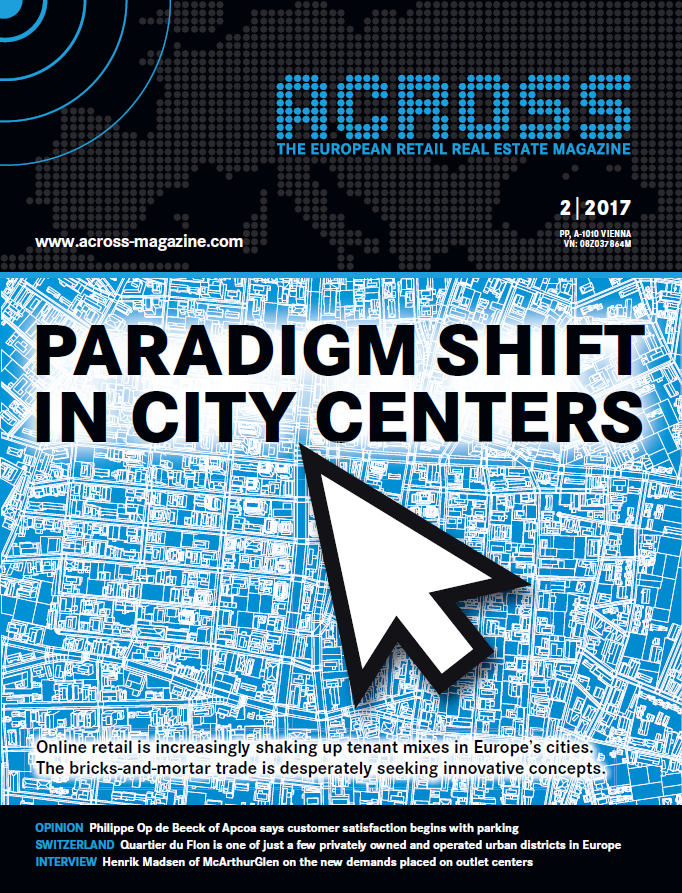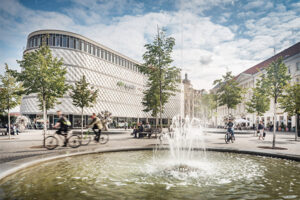Europe’s retail landscapes are facing a radical change. “Online retail” is the new old bugbear of city fathers and stationary retailers.
 International experts agree that metropolitan inner-city areas could be particularly hard hit in the future. How is the e-commerce phenomenon affecting the tenant mix of urban centers? Might online retail even destroy Europe’s city centers?
International experts agree that metropolitan inner-city areas could be particularly hard hit in the future. How is the e-commerce phenomenon affecting the tenant mix of urban centers? Might online retail even destroy Europe’s city centers?
If one believes current studies done across the continent, this scenario is quite realistic. If bricks-and-mortar retailing was always linked with time and space, e-commerce now seems to be overturning that iron law.
Online retail promises customers the ability to buy anywhere and at any time. Hardly anyone today doubts that the ongoing digitalization of retail is coming mainly at the expense of stationary traders.
Many retailers risk going under
For example, the Institute for Retail Research’s latest “City, Country, Retail 2020” report warns that, even now, every 10th store in Germany is threatened with closure. This mainly affects small and medium-sized cities, the study’s authors say.
They blame growing shop vacancies on both online retail and traditional retailers’ lack of willingness to change. Many municipalities with populations below 100,000 are already fighting desperately for the survival of their retailers and small business—and thus for the survival of their city centers.
But even larger cities will be affected in the future. 45,000 sporting goods retailers, toy stores, electronics stores, and boutiques will be at risk in Germany by 2020, the Institute for Retail Research reports.
“The fashion retail sector, which is present in every town and has always been part of the urban domain, is constantly losing ground,” says Hannes Lindner, Managing Partner of the Austrian consulting firm Standort + Markt.
Since 2013, the company has studied the retail areas of Austria’s largest cities by conducting detailed surveys of individual companies.

A surprising result: “The proportion of area devoted to fashion has fallen successively from 35.5% to 33.9% in the studied cities in the last four years,” said Lindner. This shows that the cities are being hit hard in their ancestral domains—not just by young agglomerations (shopping malls, retail parks, and big box agglomerations), but already quite clearly by e-commerce, Lindner believes. The long-term observations have also confirmed that the retail sector in general—though currently only piecemeal—is being displaced slightly from the mix in city centers. For example, retail’s share of shop areas in Austria’s cities has decreased from 75.0% to 73.4% over the past four years. The new motto is (first) “dine out” (then) “work out.” Restaurant and leisure spaces are growing as a consequence. “I suspect that it will be similar in other European cities,” said Lindner.
Chain stores dominate
The paradigm shift is hitting small- and medium-sized retailers in Europe’s inner cities particularly hard. The high proportion of chain stores and sky-high rents in prime locations are displacing weaker retailers to the edge of city centers, where the battle for survival is even more intense. Conclusion: Vacancy rates in city centers and fluctuations among stationary retailers will rise continuously.
While large retail companies are relying more and more on multi-channel services and experiences, owner-managed retailers generally cannot keep up with the latest technological developments. Since owner-operated retailers seldom have the capacity and know-how to develop a multi-channel strategy, this results in the erosion of business conditions—particularly in small- and medium-sized cities, the retail landscapes op which consist mainly of specialist retailers.
The electronics retailer Saturn shows what a modern multi-channel strategy could look like with its new concept “Saturn Connect.” In busy downtown locations, 300- to 700-sq-m Saturn Connect stores offer not only lifestyle products in an “experience” ambiance, but also comprehensive advice and services—from instant smartphone repair, to computer help, to data transfers. With its multi-vendor product range and service offer, “Saturn Connect” wants to be THE place for tech-savvy customers in inner cities.

The French sporting goods retailer Decathlon, too, has recently reinforced its online business with “Decathlon Connect.” “Connect” in this case stands for a permanent link. Individual components mesh with one another: for example, innovation is linked to a proven shopping concept and online shopping is linked with offline. Tests are currently running to gauge how the “connect” concept can be integrated into stores. It is not about an independent branch concept, but about a new way to supplement the traditional, large-scale operations with a digital component. The concept’s focus is on digital services like click & collect, which merge with the online shop.
Micro retail on the high street?
But are large areas—albeit in combination with pick-up stores—really the last word amid shrinking retail space requirements? Or is micro retail perhaps the panacea for Europe’s high streets? Micro retail quite clearly follows the trend of efficient use of space. It’s no longer a question of how large a store is, but about how it uses its space optimally and efficiently.
The UK’s Doddle is a current example of micro retail. The UK parcel collection and delivery service Doddle prioritizes location over floor space. The company operates 44 stores across the country, with a focus on train stations. Its target customers are commuters who may not be home to collect parcels, but can’t get to the post office within working hours. The company has also identified other locations that suit its services, such as shopping centers and university campuses.
The furniture retailer Ikea has apparently also discovered a new venue for itself. The Swedish furniture company is planning to open a store in a central, urban location in the heart of Vienna—namely at Vienna West station. The store will be aimed at visitors who arrive on foot, by public transport, or by bicycle. Ikea will be moving into the “blue house” next to the train station. The plan is to develop an architectural concept adapted to the urban space, including landscaped green spaces on various levels.
Car-free city centers
While Ikea is obviously betting on a car-free furniture store in Vienna, the idea is being taken a step further in the far north. By 2019, the new city government in Oslo, Norway, wants to ban all cars from the city center. That could make Oslo (pop. 600,000) the first car-free European capital.

Although only about 1,000 people live in the affected downtown areas, around 90,000 work and shop in the area every day, so the affected traffic volume is substantial. It’s thus no wonder that regional business representatives and retailers, in particular, are stomping hard on the brakes on this project.
The creation of new regional town centers and district developments across Europe is also creating a mess for the inner-city retail trade. Infrastructure is a key issue, particularly for medium-sized centers. Although international creative centers have the potential to revive neglected districts with new formats, experts fear a gradual thinning of retail space in traditional city centers. Whether the threat of space migrating out of city centers can be met just by increasing the space devoted to gastronomy and service concepts is doubtful, however.
How do things look for new and innovative store formats in prime locations? “I wish it were different. But when I look at H&M, for example, which is abandoning the budget format with Cos and & Other Stories, I’m rather skeptical. The big retailers are increasingly diversifying and trying to tap into different price categories. The scope for individualists remains very small,” says Hannes Lindner of the retail advisory firm Standort + Markt, pessimistically.
Pessimism is also spreading among some town representatives and in retail due to the growing power of online multinationals. Even though the official opening of Amazon’s high-tech supermarket “Amazon Go” in Seattle has been postponed until further notice due to technical inadequacies, it seems certain that the supermarket without staff will come eventually. As Lindner commented, “What happens when Amazon becomes stationary? That’d really be like Godzilla.”





